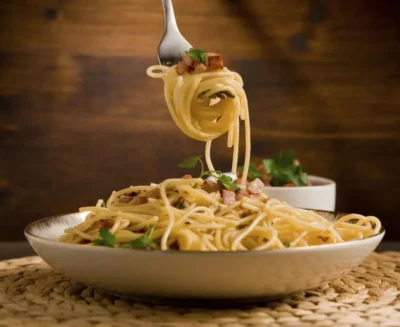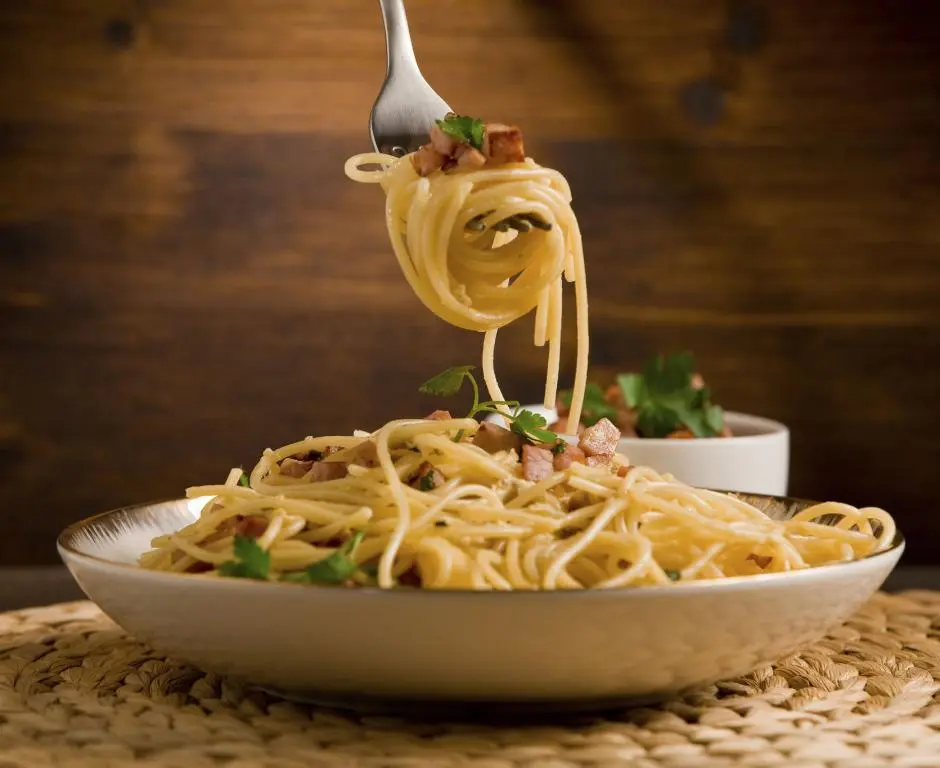Pasta Carbonara is a timeless Italian dish known for its creamy, rich sauce made from eggs, cheese, and pancetta. This classic recipe combines pasta with a savory mix of crispy pancetta and a smooth, velvety sauce that clings to each strand. It’s a quick and comforting meal that captures the essence of Italian home cooking.
Serving Suggestions
Serve Pasta Carbonara immediately after preparing, garnished with extra grated Parmesan cheese and a sprinkle of freshly cracked black pepper.
It pairs well with a simple green salad and a side of garlic bread or crusty baguette. For an added touch, consider a light drizzle of basil olive oil or a few fresh basil leaves.
Pairing Ideas
This dish complements a variety of sides and accompaniments. It works well with a fresh green salad, providing a crisp contrast to the creamy pasta. It also pairs nicely with steamed vegetables or a side of roasted tomatoes. For a more substantial meal, enjoy it with a side of sautéed spinach or a light vegetable soup.
Tips and Notes
- Pasta: Use a high-quality pasta, such as spaghetti or fettuccine, for the best texture. Cook it al dente to prevent it from becoming mushy when mixed with the sauce.
- Sauce: Mix the eggs and cheese together thoroughly before adding to the pasta to ensure a smooth, creamy sauce. Avoid overcooking the sauce; it should be just warm enough to coat the pasta without scrambling the eggs.
- Pancetta: Cook the pancetta until it is crisp and golden to add a flavorful crunch to the dish. You can substitute pancetta with bacon if needed.
- Storage: Store any leftover pasta in an airtight container in the refrigerator for up to 2 days. Reheat gently on the stovetop, adding a splash of cream or milk to loosen the sauce if needed.
Enjoy the rich and creamy flavors of Pasta Carbonara as a comforting and satisfying meal!

Pasta Carbonara
Equipment
- Large pot for boiling pasta
- Large skillet or frying pan
- Mixing bowl
- Whisk
- Cheese grater
Ingredients
- 400 g about 14oz spaghetti
- 150 g about 5oz pancetta or guanciale, cubed
- 2 large eggs and 2 egg yolks
- 1 cup Pecorino Romano cheese - freshly grated
- Freshly ground black pepper - to taste
- Salt - to taste
- Fresh parsley - chopped (optional, for garnish)
Instructions
- Cook the Pasta: Bring a large pot of salted water to a boil. Add the spaghetti and cook according to package instructions until al dente. Reserve 1 cup of pasta water, then drain.
- Cook the Pancetta: While the pasta is cooking, heat a large skillet over medium heat. Add the pancetta and cook until it is crispy and golden brown, about 5-7 minutes. Remove from the heat.
- Mix the Sauce: In a mixing bowl, whisk together the eggs, egg yolks, and Pecorino Romano cheese. Season generously with freshly ground black pepper.
- Combine: Add the drained pasta to the skillet with the pancetta. Over low heat, pour the egg and cheese mixture onto the pasta, quickly tossing the pasta to coat it in the sauce. Add a little reserved pasta water if the sauce is too thick, until it reaches your desired consistency.
- Serve: Serve immediately, garnished with additional Pecorino Romano, black pepper, and optional parsley.
